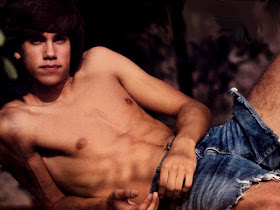One of my first crushes was on Davy Jones, singer for the pre-fab boy band The Monkees. In fact, the first album I ever bought (or rather, asked Mom and Dad for) was The Monkees (1966), because it showed Davy Jones seated in the foreground, dirty from working outdoors, with Peter Tork's arm around him. I figured they were boyfriends.
Some of the tracks were gender-explicit, with lots of “girls” and “babes," but many were not, including the famous “Last Train to Clarksville", written by the famous duo Boyce and Hart: the singer, talking on the telephone, asks a loved one for a final rendezvous in a train station before he goes away forever.
Quite a change from the girl-crazy Beatles and Herman's Hermits.
More of the Monkees (1967) again had an evocative cover, with the boys in blue shirts and tight jeans gazing down suggestively at the camera. But every track was about desperate longing for some girl or another, with a single exception. In “Laugh,” which didn’t chart as a single, Davy Jones suggests that those boys who are interested in boys should transform their "secret" into humor:
Laugh, when you're keepin' a secret
And it seems to be known by the rest of the world.
Laugh, when you go to a party
And you can't tell the boys from the girls.
 The tv series (1966-68, then on Saturday morning 1968-70) seemed to concur. The nonsensical plots, filled with blackout gags, self-referential humor, and spoofs of every movie cliché from superheroes to Westerns, were surprisingly gay-friendly. And shirtless shots were quite common.
The tv series (1966-68, then on Saturday morning 1968-70) seemed to concur. The nonsensical plots, filled with blackout gags, self-referential humor, and spoofs of every movie cliché from superheroes to Westerns, were surprisingly gay-friendly. And shirtless shots were quite common.
Although Micky Dolenz was ostensibly the leader of the group, Davy Jones, only 5’3”, with dark eyes and a sensual pout, quickly became the standout star. He was prominently displayed on every album cover, and almost every episode required him to wear a swimsuit or revealing prizefighter’s trunks, or get his clothes ripped off by fans, or otherwise display his slight but firm physique.
 Unfortunately, he also got the most girl-chasing plotlines. Of 58 episodes, Davy went ape over a girl in six, Peter Tork in two, Micky in only one, and Mike Nesmith not at all.
Unfortunately, he also got the most girl-chasing plotlines. Of 58 episodes, Davy went ape over a girl in six, Peter Tork in two, Micky in only one, and Mike Nesmith not at all.
Micky is the one that I figured liked boys, not girls. My evidence: the voice-over introduction to “Monkees on the Wheel” (December 1967) notes that Las Vegas is the
Pleasure capital of the world, where each man seeks the things he loves most. [Shot of Peter following a girl.]
The things he loves most. [Shot of Mike following a girl.]
The things he loves most.[Shot of Davy following a girl.]
And then the story begins. Why is Micky omitted? Because the joke has run its course, or because girls are not the things he loves most?
Also, in “Monkees Mind their Manors” (February 1968), the group travels to England. At the airport, the boys realize that the customs agent is being portrayed by Jack Williams, the show’s prop master, but Williams protests that he is actually a famous singer. Then he sings the Dean Martin standby “Everybody Loves Somebody Sometime”, and Micky, overcome with passion, leaps into his arms.
Many minor characters were gay-vague, such as the flamboyant Sir Twiggly Toppin Middle Bottom (Bernard Fox) and beach movie star Frankie Catalina (Bobby Sherman), who hates the beach and is “allergic to girls” (i.e., gay).
Pleasure capital of the world, where each man seeks the things he loves most. [Shot of Peter following a girl.]
The things he loves most. [Shot of Mike following a girl.]
The things he loves most.[Shot of Davy following a girl.]
And then the story begins. Why is Micky omitted? Because the joke has run its course, or because girls are not the things he loves most?
Also, in “Monkees Mind their Manors” (February 1968), the group travels to England. At the airport, the boys realize that the customs agent is being portrayed by Jack Williams, the show’s prop master, but Williams protests that he is actually a famous singer. Then he sings the Dean Martin standby “Everybody Loves Somebody Sometime”, and Micky, overcome with passion, leaps into his arms.
Many minor characters were gay-vague, such as the flamboyant Sir Twiggly Toppin Middle Bottom (Bernard Fox) and beach movie star Frankie Catalina (Bobby Sherman), who hates the beach and is “allergic to girls” (i.e., gay).
And the Monkees themselves obviously preferred buddy-bonding over girl-chasing. I couldn't wait to see their constant caressing of faces, hands, and chests, their cuddling together, their panicked hugging in moments of danger. Regardless of what the actors thought they were conveying, for gay kids they produced a powerful evocation of same-sex love.
See also my review of Head, the Monkees' swan song.
See also my review of Head, the Monkees' swan song.


























